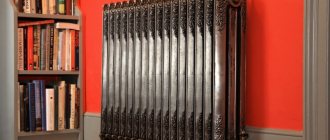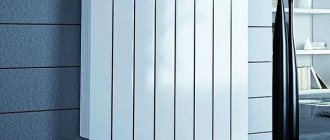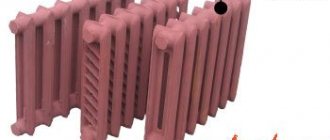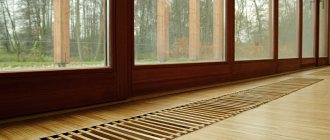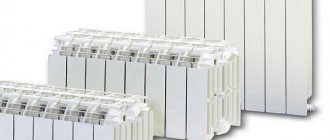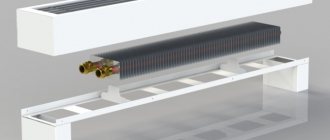Features of floor radiators
Floor radiators are reliable and durable sources of thermal energy.
They are necessary where it is impossible to install wall-mounted devices: on partitions made of plasterboard and glass blocks, with a large glazed area of vertical surfaces.
Principle of operation
Floor radiators are elements of a water heating system that works according to the following principle:
- in the boiler room the water is heated to the required temperature;
- it is supplied through a pipeline to the radiators and fills them;
- the instrument body heats up.
Heat is transferred into the room in two ways:
- radiation (up to 80% of the total power);
- convection.
The percentage of convection-radiation depends on the design of the device. Panel and sectional type batteries primarily operate on the principle of radiant heat. In this case, the waves are directed perpendicular to the surface of the device and at a slight angle in both directions.
If the radiator has a heat exchanger, which is a finned tube, then air fills the space between the fin plates. In this case, heat transfer is carried out primarily by natural convection. Heated air masses rise to the ceiling space, and cold ones take their place. Floor-mounted devices operate on this principle.
Photo 1. Design of a floor heating radiator. Arrows indicate the components of the device.
Advantages and disadvantages
The main advantage of floor-standing batteries is considered to be minimal heat loss. This effect is achieved through the carefully thought-out design and shape of the instrument body. Other benefits include:
- simplicity and ease of installation;
- aesthetic appeal inherent in modern models of heating equipment;
- wide selection of equipment with different thermal power;
- affordable price;
- possibility of adjusting the heating temperature.
Flaws:
- uneven heating of the room: the upper space becomes warm faster, while the air at floor level is cool;
- are not always able to fit harmoniously into the design of the room;
- cannot be masked by furniture or partitions placed in front of them.
Installation
Connecting a floor radiator to a heating system is technically no different from installing a wall radiator. Perform the same actions:
- Mayevsky taps or taps with a thermostat are installed at the input and output of the battery;
- sealing of threaded connections is carried out using flax and Unipak sealing paste;
- check the correct installation using a bubble level: the top panel of the heater must be strictly horizontal.
Reference. Each line of floor radiators has feed-through and end models. The first ones are designed for installation at any point in the heating system. Terminals are installed at the end of each branch of the utility network.
Panel-type floor radiators are prefabricated. Before connecting to the heating system, you need to perform several steps:
- remove the top and side panels;
- install legs;
- fix previously removed panels in their original places.
To make floor-standing appliances more stable, heating equipment manufacturers have developed special brackets. They are attached to the floor surface, after which the legs or battery housing are screwed on. If necessary and for greater ease of installation, height-adjustable brackets are used.
Photo 2. Special brackets with a floor-mounted bimetallic heating radiator suspended on them.
Possible alternatives
An in-floor convector allows you to save space, but is inconvenient to clean.
Floor-mounted radiators can be replaced with other devices if it is necessary to create an aesthetic design.
Built-in options
The in-floor unit allows heating to be installed in a hidden way. It is installed in the floor, and a decorative grille is used to remove thermal energy, standing flush with the coating. Built-in modifications differ:
- ability to withstand pressure from 10 to 16 bar;
- thermal power from 13 to 100 kW;
- water heating limit from 110 to 130 degrees;
- simplicity of design, light weight and compactness;
- corrosion resistance;
- hidden location - mounted in a doorway or floor covering;
- uniform heating of the room;
- preventing fogging of window structures.
Due to the large installation length and the need to create a niche, it is better to design the location of the sections at the construction stage. The models operate only on the radiation principle, so their heat transfer is minimal.
Skirting convectors
Uniform heating of the bathroom can be achieved by installing baseboard radiators.
It is not always possible to install radiators in the bathroom, so you can opt for warm baseboards. Products differ:
- height from 20 to 25 cm and depth 10 cm;
- efficiency - fuel costs are reduced by 50%;
- thermal power from 50 to 150 kW;
- operating pressure limit up to 16 atm;
- heating the water to 130 degrees;
- protection against overheating thanks to a thermostat;
- ease of installation;
- uniform distribution of heat flows.
Low water floor heating radiators should only be installed by specialists. If the technology is not followed, the wall decoration can be damaged.
Scope of use of floor radiators
First, let's figure out where heating devices that are installed on the floor are used.
It is advisable to use water floor radiators in the following cases:
- In rooms where, for one reason or another, it is not possible to install traditional radiators for wall mounting. This often happens in houses where the walls are made of loose material (aerated concrete, foam concrete) or covered with plasterboard. Even light aluminum appliances cannot be hung on them.
- In shop windows and shopping centers, low floor heating radiators are used for panoramic windows. Such glazing cannot be left without a thermal curtain, because condensation will accumulate on the windows and ice will form.
Unlike wall-mounted heating units, floor-standing radiators are installed only on the floor and are not mounted on walls. The height of these devices is less than that of their sectional counterparts. The stand for the unit is rigidly attached to the floor.
Advantages and disadvantages
The advantages of low heating radiators include the following:
- the unit can be mounted anywhere, regardless of the height of the windows;
- a low heating device saves free space in the room;
- Thanks to its stylish design and attractive appearance, the battery does not spoil the interior of the room and fits into any room design;
- can be installed in a room with panoramic windows to create a thermal curtain in front of them;
- during installation, the material and strength of the walls does not matter, because the batteries are not attached to them.
Such heating devices also have disadvantages, they are as follows:
- To connect the battery to the heating system, you need to lay pipes in the floor screed, because they will interfere with the placement of furniture. Hidden installation of pipelines is considered not the best option, because it is more difficult to maintain and repair networks.
- The heat from these heating devices is distributed unevenly, so the unit is not suitable for heating rooms of considerable height. In this case, some areas of the room may not be heated at all.
- Due to the hidden installation of pipelines, the floor screed in the room is made to a certain height, which creates difficulties when attaching radiators.
A significant disadvantage of floor heating units is that they are more expensive than sectional wall-mounted radiators, and they heat the room worse.
Types of floor batteries
All horizontal heating radiators that are mounted on the floor are divided into several types depending on the material used:
Cast iron batteries were widely used in the last century, but they cannot boast of aesthetic appeal. Their main disadvantage is that the inside of the structure quickly silts up, so it needs to be cleaned regularly (about once every three years). When subjected to mechanical stress, cast iron can crack. The same thing happens with water hammer. Steel radiators are more popular today. They are quite durable and visually attractive. However, steel plate devices often leak in the weld area. The most reliable and beautiful bimetallic units. There is a steel core inside the aluminum body. Thanks to this, the heat transfer of the device is quite high, and optimal strength allows them to be installed in centralized networks with high pressure. Aluminum batteries are the lightest, but they are not designed for high pressure in the network, therefore they are used only in autonomous systems
It is important to carefully select the material of pipes and fittings, because aluminum forms galvanic couples with some metals.
By design, floor-standing units can be panel or sectional. Panel batteries are made only from steel, while sectional batteries are made from bimetal, cast iron or aluminum. In addition, all heating devices come in different heights.
Important! Higher batteries have the smallest heat loss with a small number of sections
Installation features
Installing recessed batteries into the floor does not require special preparation. In order to do this yourself, you need to thoroughly study the design of heating equipment in the house.
Trench convector POLVAX
To extend the service life of devices, ensure efficient heating of the room and not waste a lot of money and effort, when installing radiators you should pay attention to the following nuances
- Pressure in the central heating system.
Since in-floor radiators are primarily intended for heating country houses, they are generally not designed to withstand the pressures inherent in central heating systems. If you nevertheless decide to install a built-in radiator in an apartment in a multi-storey building, then when choosing a model you should rely, first of all, on this indicator. Installation of an in-floor convector - The height of the ceilings in the room. The larger the volume of the room that needs to be heated, the greater the power of the built-in radiators should be. The calculation is carried out using the formula 1 kW per 10 sq. m.
- Electrical supply to water-type heating radiators. This point should be considered at the building design stage or before the renovation of the premises begins. Otherwise, you can only install a radiator with an electric heater.
- Floor space required to install radiators. In this case, they rely on the dimensions of the devices. There should be a space between the floor and the radiator, the height of which varies depending on the model of the device.
Installation of an in-floor convector
Table. Step-by-step instructions for installing a floor-mounted radiator with a water heater.
| Steps, photo | Description of actions |
Step 1 | Together with the “warm floor” system, you can install in-floor convectors for additional heating of stained glass windows facing the north or north-west side of the house. They will also serve as heaters in the off-season, when you need to provide the house with a small amount of heat without using the entire heating system. Thus, cost savings are achieved. |
Step 2 | In terms of dimensions, the radiator model is selected depending on the height of the “warm floor” system. Preference should be given to models with a built-in fan, which will blow the glass of the stained glass window and effectively combat condensation. |
Step 3 | Central heating pipes are installed and insulated. For radiators with a fan, you will need to install an electrical cable and install a thermostat to monitor the temperature. |
Step 4 | In-floor convectors are connected to the centralized system by connecting to radiator pipes, located, as a rule, on the side in a compartment hidden under a decorative cover. |
Step 5 | The distance from the stained glass window to the battery must be at least 50 mm. If you build a convector into the opening of a stained glass window, then its area is significantly reduced and, accordingly, its efficiency decreases. But at the same time, the device does not take up extra space and will not be interfered with by curtains when blowing on stained glass windows. |
Step 6 | The device comes with instructions, after studying which you can easily connect the radiator according to all the rules and ensure its effective service for many years. |
Summing up
In general, we can say with confidence that installing floor-mounted radiators, if they are not built into the floor, is even simpler than installing wall-mounted heating radiators.
They take up little space, look aesthetically pleasing and can even decorate a room, being a noteworthy decorative element.
Until recently, their assortment in stores left much to be desired, but over time they began to appear on sale more and more, providing a good alternative to the usual pendant batteries.
When choosing heaters, you can now be guided not only by parameters such as power, weight, material and manufacturer’s warranty period, but also choose style, convenience and elegance.
In what rooms are floor-mounted radiators installed?
Some models have additional functions, such as condensate drainage, automatic regulation, and programmable climate control.
Trench convector
Such radiators are most in demand in rooms where it is necessary to create a special microclimate:
- in greenhouses;
- in museums;
- in galleries;
- in houses with panoramic windows.
Radius/angular in-floor convector
The versatility and multifunctionality of radiators built into the floor contribute to the fact that they are preferred when organizing heating in both residential and office premises, as well as in commercial premises.
Built-in convectors are sometimes installed in window sills
It's more difficult with built-in ones
The situation is completely different with floor-standing batteries built into the floor.
Aesthetically, they are, of course, much more attractive than others, but do not forget that their installation must be planned at the stage of construction or major repairs, since such radiators require special niches or channels in the floor for laying pipes and embedding the radiators themselves.
Otherwise, you will have to redo the entire floor to install them.
Advantages of radiators built into the floor
Heating radiators built into the floor are an excellent way to solve heating issues, regardless of the purpose of the premises and their area.
They have many advantages over traditional heating system options:
- reliability, environmental friendliness, reliability, resistance to the influence of aggressive environments. They are designed to last for many years of use;
- high productivity at minimal cost. High-quality heating, if a radiator is installed built into the floor, can be provided thanks to traditional water heating, which forms the basis of in-floor structures;
- the ability to conceal the battery inside the floor. Such design features allow consumers not to worry that the radiators will not fit into the modern interior of an office, stylish home or shopping center;
- maximum preservation of free space if radiators are installed under the floor. After installing the heating radiators, furniture and various interior items can be placed close to the walls of the room;
- When installing a heating system with radiators built into the floor, property owners have the opportunity to install all-glass windows on the entire wall. This design solution is most relevant in the construction of country cottages.
The design of an in-floor radiator, details in the video:
https://youtube.com/watch?v=PJUwyx4jjtc
Furniture items
A few examples of furnishing a kitchen combined with a living room:
- 1. Sofa. It becomes an object that zones space. The sofa is placed with its back facing the place where food is prepared. In small rooms (less than 20 sq m) a corner is placed, which is placed against a wall installed perpendicular or parallel to the kitchen.
- 2. Set. According to designers, minimalist models without elaborate details look modern. The service, vases or glasses are placed on an open shelf. You can buy a fashionable display case for them. Furniture is placed near the wall. If the space is large (20 sq. m, 25 sq. m or 30 sq. m), then in the central part you can install an island, which also has sections for kitchen appliances.
- 3. Furniture set. The style should be combined with the design of both rooms. In small rooms, a compact table and chairs made of transparent material or painted in light colors look good. You can add a table with a round top to your living room interior. In spacious rooms, the kit is installed near the wall or in the central part. An elongated rectangular dining table would look good here.
Heating in baseboards
Relatively recently, a new and lowest method of creating heating has appeared. In this case, the heat supply structure consists of copper tubes finned with plates, due to which heat transfer increases. Water circulates through them.
The tubes are laid around the perimeter of the room and covered with special metal baseboards. This heating design has the smallest dimensions. It is 30 millimeters wide and has a height of 100–200 millimeters (depending on the power of the system).
Heating in baseboards has the following advantages:
- Great opportunities for implementing design solutions in the interior.
- Uniform distribution of warm flows along the walls.
When a unique design is created in a room, it is low radiators for stained glass windows that allow the heating system to be correctly and beautifully integrated into the interior.
Advantages and disadvantages of floor-standing models
Floor radiators are connected to the general heating system and installed on legs
A floor-standing radiator unit can be installed on special legs or built into the floor surface, mounted like a plinth. Compared to standard options, they have several advantages:
- compactness – small-sized products do not clutter up the space;
- high heat transfer coefficient of models made of cast iron, bimetal, aluminum;
- laconic appearance - suitable for any interior design;
- several color options - standard batteries are made in white, but manufacturers paint them according to the RAL catalog, playing with different textures;
- ease of installation - installation work is reduced to connecting to the heating system or screwing into the floor;
- efficient heating of a room where there is a large window;
- Possibility of installation next to walls.
The disadvantages of floor heating radiators include the need to organize floor wiring and the difficulty of finding the right model in offline stores. Disadvantages also include low price compared to classic options and heating using convection technology.
Design solutions
It is impossible to build a regular battery into glass, and low floor ones are an excellent solution here. Located at the bottom of large glass panes, they prevent them from icing and at the same time successfully cope with heating the premises.
In addition, floor-standing appliances are sometimes installed as a decorative element, combining the useful with the aesthetic, since they often look quite stylish.
Photos of such floor heating radiators are often posted on design websites.
Bimetallic radiators
Batteries are made of composite material, mainly steel and aluminum are used for manufacturing. The first component is used to create the internal tubes, the second - for the external heat-dissipating fins. This arrangement allows for strong and durable heating installations. Bimetallic heating devices are produced abroad, so they are quite expensive.
The main advantages of bimetallic heaters:
- High heat dissipation;
- Resistance to water hammer and internal pressure surges;
- Economical consumption of heating components;
- Quick installation.
Disadvantages: high cost.
Separately, it is worth mentioning autonomous oil radiators. Floor installations of this type do not depend on the public heating system and will be useful during the period of the year when it is not yet switched on. Unfortunately, electric oil batteries consume a lot of energy and cannot be considered economical heating sources.
https://youtube.com/watch?v=AIEgi_eDjUM
Cast iron batteries
These radiators have been used for a long time to this day. With the advent of new, lighter materials, preference began to be given to them, removing old, unaesthetic-looking cast iron radiators from apartments, but recently cast iron radiators have begun to come into fashion again.
And this is not surprising, because at a low cost they have enormous strength and high reliability.
But for many, the heavy weight and difficulty in maintaining are the fundamental disadvantages of this type of device.
Today cast iron products are produced in two types:
- classic budget “accordions” in the “cheap and cheerful” style in a wide variety of colors and options for painting
- exquisite expensive designer models in retro style, each of which is a kind of masterpiece, and the cost can be very, very high.
Aluminum heaters
These devices, very light, but at the same time quite durable, are usually used for autonomous heating, since low-quality coolants in centralized systems can cause rapid corrosion.
In addition, they are quite sensitive to surges in water pressure. They are produced in two ways:
- injection molding method, where step-by-step processing ensures maximum smoothness of surfaces, and an anti-corrosion coating is applied inside and outside, after which the body is coated with special powder paint
- an extrusion method in which the vertical parts are made of aluminum, and the manifold is made of silumin (aluminum-silicon alloy), hermetically connecting all parts to eliminate the risk of leaks.

